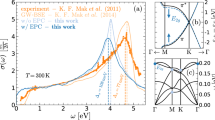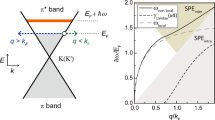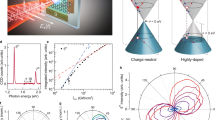Abstract
In quantum optics, great effort is being invested in enhancing the interaction of quantum emitters with light. The different approaches include increasing the number of emitters, the laser intensity or the local photonic density of states at the location of an atom-like localized emitter. In contrast, solid-state extended emitters hold an unappreciated promise of vastly greater enhancements through their large number of vacant electronic valence states. However, the majority of valence states are considered optically inaccessible by a conduction electron. We show that, by interfacing three-dimensional (3D) solids with 2D materials, we can unlock the unoccupied valence states by nonlocal optical interactions that lead to ultra-strong coupling for each conduction electron. Consequently, nonlocal optical interactions fundamentally alter the role of the quantum vacuum in solids and create a new type of tunable mass renormalization and bandgap renormalization, which reach tens of millielectronvolts in the example we show. To present quantitative predictions, we develop a non-perturbative macroscopic quantum electrodynamic formalism that we demonstrate on a graphene–semiconductor–metal nanostructure. We find new effects, such as nonlocal Rabi oscillations and femtosecond-scale optical relaxation, overcoming all other solid relaxation mechanisms and fundamentally altering the role of optical interactions in solids.
This is a preview of subscription content, access via your institution
Access options
Access Nature and 54 other Nature Portfolio journals
Get Nature+, our best-value online-access subscription
$29.99 / 30 days
cancel any time
Subscribe to this journal
Receive 12 print issues and online access
$209.00 per year
only $17.42 per issue
Buy this article
- Purchase on Springer Link
- Instant access to full article PDF
Prices may be subject to local taxes which are calculated during checkout




Similar content being viewed by others
Data availability
Source data are available for this paper. All other data that support the plots in this paper and other findings of this study are available from the corresponding author.
Code availability
The code that supports the findings of this study is available from the corresponding author.
References
Welton, T. A. Some observable effects of the quantum-mechanical fluctuations of the electromagnetic field. Phys. Rev. 74, 1157–1167 (1948).
Coldren, L. A. & Corzine, S. W. Diode Lasers and Photonic Integrated Circuits (Wiley, 1995).
Sanchez-Mondragon, J. J., Narozhny, N. B. & Eberly, J. H. Theory of spontaneous-emission line shape in an ideal cavity. Phys. Rev. Lett. 51, 550–553 (1983).
Yablonovitch, E. Inhibited spontaneous emission in solid-state physics and electronics. Phys. Rev. Lett. 58, 2059–2062 (1987).
Purcell, E. M. Spontaneous emission probabilities at radio frequencies. Phys. Rev. 69, 681 (1946).
Haroche, S. & Kleppner, D. Cavity quantum electrodynamics. Phys. Today 42, 24–30 (1989).
Khurgin, J. B. Excitonic radius in the cavity polariton in the regime of very strong coupling. Solid State Commun. 117, 307–310 (2001).
Ciuti, C., Bastard, G. & Carusotto, I. Quantum vacuum properties of the intersubband cavity polariton field. Phys. Rev. B 72, 115303 (2005).
Günter, G. et al. Sub-cycle switch-on of ultrastrong light–matter interaction. Nature 458, 178–181 (2009).
Todorov, Y. & Sirtori, C. Intersubband polaritons in the electrical dipole gauge. Phys. Rev. B 85, 045304 (2012).
Schwartz, T., Hutchison, J. A., Genet, C. & Ebbesen, T. W. Reversible switching of ultrastrong light-molecule coupling. Phys. Rev. Lett. 106, 196405 (2011).
Scully, M. O. Collective Lamb shift in single photon Dicke superradiance. Phys. Rev. Lett. 102, 143601 (2009).
Hümmer, T., García-Vidal, F. J., Martín-Moreno, L. & Zueco, D. Weak and strong coupling regimes in plasmonic-QED. Phys. Rev. B 87, 115419 (2013).
Forn-Díaz, P., Lamata, L., Rico, E., Kono, J. & Solano, E. Ultrastrong coupling regimes of light–matter interaction. Rev. Mod. Phys. 91, 025005 (2019).
Kockum, A. F., Miranowicz, A., De Liberato, S., Savasta, S. & Nori, F. Ultrastrong coupling between light and matter. Nat. Rev. Phys. 1, 19–40 (2019).
Basov, D. N., Fogler, M. M. & Garcia de Abajo, F. J. Polaritons in van der Waals materials. Science 354, aag1992 (2016).
Low, T. et al. Polaritons in layered 2D materials. Nat. Mater. 16, 182–194 (2016).
Rivera, N., Christensen, T. & Narang, P. Phonon polaritonics in two-dimensional materials. Nano Lett. 19, 2653–2660 (2019).
Jablan, M., Buljan, H. & Soljačić, M. Plasmonics in graphene at infrared frequencies. Phys. Rev. B 80, 245435 (2009).
Giles, A. J. et al. Ultralow-loss polaritons in isotopically pure boron nitride. Nat. Mater. 17, 134–139 (2017).
Ni, G. et al. Fundamental limits to graphene plasmonics. Nature 557, 530–533 (2018).
Koppens, F. H. L., Chang, D. E. & García de Abajo, F. J. Graphene plasmonics: a platform for strong light–matter interactions. Nano Lett. 11, 3370–3377 (2011).
Principi, A., van Loon, E., Polini, M. & Katsnelson, M. I. Confining graphene plasmons to the ultimate limit. Phys. Rev. B 98, 035427 (2018).
Alcaraz Iranzo, D. et al. Probing the ultimate plasmon confinement limits with a van der Waals heterostructure. Science 360, 291–295 (2018).
Rivera, N., Kaminer, I., Zhen, B., Joannopoulos, J. D. & Soljačić, M. Shrinking light to allow forbidden transitions on the atomic scale. Science 353, 263–269 (2016).
Kurman, Y. et al. Control of semiconductor emitter frequency by increasing polariton momenta. Nat. Photon. 12, 423–429 (2018).
Machado, F., Rivera, N., Buljan, H., Soljacic, M. & Kaminer, I. Shaping polaritons to reshape selection rules. ACS Photonics 5, 3064–3072 (2018).
Lundeberg, M. et al. Tuning quantum non-local effects in graphene plasmonics. Science 357, 187–191 (2017).
Christensen, T. et al. Nonlocal response of metallic nanospheres probed by light, electrons and atoms. ACS Nano 8, 1745–1758 (2014).
Yan, W., Wubs, M. & Mortensen, N. A. Hyperbolic metamaterials: nonlocal response regularizes broadband supersingularity. Phys. Rev. B 86, 205429 (2012).
Grosso, G. & Parravicini, G. P. Solid State Physics 2nd edn (Academic Press, 2013).
Giustino, F. Electron–phonon interactions from first principles. Rev. Mod. Phys. 89, 015003 (2017).
Mahan, G. D. Many-Particle Physics 3rd edn (Springer, 2000).
Glauber, R. J. & Lewenstein, M. Quantum optics of dielectric media. Phys. Rev. A 43, 467–491 (1991).
Scheel, S. & Buhmann, S. Y. Macroscopic QED—concepts and applications. Acta Phys. Slov. 58, 675–809 (2008).
Vogel, W. & Welsch, D.-G. Quantum Optics 3rd edn (Wiley, 2006).
Sundaresan, N. M. et al. Beyond strong coupling in a multimode cavity. Phys. Rev. X 5, 021035 (2015).
Polini, M. et al. Plasmons and the spectral function of graphene. Phys. Rev. B 77, 081411 (2008).
Song, J. C. & Levitov, L. S. Energy flows in graphene: hot carrier dynamics and cooling. J. Phys. Condens. Matter 27, 164201 (2015).
Rosker, M. J., Wise, F. W. & Tang, C. L. Femtosecond optical measurement of hot‐carrier relaxation in GaAs, AlGaAs and GaAs/AlGaAs multiple quantum well structures. Appl. Phys. Lett. 49, 1726–1728 (1986).
Jacob, Z., Smolyaninov, I. I. & Narimanov, E. E. Broadband Purcell effect: radiative decay engineering with metamaterials. Appl. Phys. Lett. 100, 181105 (2012).
Poddubny, A., Iorsh, I., Belov, P. & Kivshar, Y. Hyperbolic metamaterials. Nat. Photon. 7, 948–957 (2013).
Fei, Z. et al. Edge and surface plasmons in graphene nanoribbons. Nano Lett. 15, 8271–8276 (2015).
Khurgin, J. B. Two-dimensional exciton–polariton—light guiding by transition metal dichalcogenide monolayers. Optica 2, 740–742 (2015).
Khurgin, J. B. Hot carriers generated by plasmons: where are they generated and where do they go from there?. Faraday Discuss. 214, 35–58 (2019).
Wang, K. et al. Coherent interaction between free electrons and cavity photons. Preprint at https://arxiv.org/pdf/1908.06206.pdf (2019).
Muñoz, M. et al. Burstein–Moss shift of n-doped In0.53Ga0.47As/InP. Phys. Rev. B 63, 233302 (2001).
Raja, A. et al. Coulomb engineering of the bandgap and excitons in two-dimensional materials. Nat. Commun. 8, 15251–15257 (2017).
Ugeda, M. M. et al. Giant bandgap renormalization and excitonic effects in a monolayer transition metal dichalcogenide semiconductor. Nat. Mater. 13, 1091–1095 (2014).
Das Sarma, S., Jalabert, R. & Yang, S.-R. E. Band-gap renormalization in semiconductor quantum wells. Phys. Rev. B 41, 8288–8294 (1990).
Walsh, A., Da Silva, J. L. & Wei, S. H. Origins of band-gap renormalization in degenerately doped semiconductors. Phys. Rev. B 78, 075211 (2008).
Ryan, J. C. & Reinecke, T. L. Band-gap renormalization of optically excited semiconductor quantum wells. Phys. Rev. B 47, 9615–9620 (1993).
Breusing, M., Ropers, C. & Elsaesser, T. Ultrafast carrier dynamics in graphite. Phys. Rev. Lett. 102, 086809 (2009).
Pogna, E. A. A. et al. Photo-induced bandgap renormalization governs the ultrafast response of single-layer MoS2. ACS Nano 10, 1182–1188 (2016).
Ulstrup, S. et al. Ultrafast band structure control of a two-dimensional heterostructure. ACS Nano 10, 6315–6322 (2016).
Gonzalez-Ballestero, C., Feist, J., Badía, E. G., Moreno, E. & Garcia-Vidal, F. J. Uncoupled dark states can inherit polaritonic properties. Phys. Rev. Lett. 117, 156402 (2016).
Hisamoto, D. et al. FinFET-a self-aligned double-gate MOSFET scalable to 20 nm. IEEE Trans. Electron Devices 47, 2320–2325 (2000).
Bostwick, A. et al. Observation of plasmarons in quasi-freestanding doped graphene. Science 328, 999–1002 (2010).
Weisskopf, V. & Wigner, E. Berechnung der natürlichen linienbreite auf grund der diracschen lichttheorie. Z. Phys. 63, 54–73 (1930).
Knöll, L., Scheel, S. & Welsch, D.-G. in Coherence and Statistics of Photons and Atoms Ch. 7.3 (Wiley, 2001).
Chew, W. Waves and Fields in Inhomogeneous Media (IEEE Press, 1995).
Wasey, J. A. E. & Barnes, W. L. Efficiency of spontaneous emission from planar microcavities. J. Mod. Opt. 47, 725–741 (2000).
Lin, X. et al. Tailoring the energy distribution and loss of 2D plasmons. N. J. Phys. 18, 105007 (2016).
Gonçalves, P. A. D. & Peres, N. M. R. An Introduction to Graphene Plasmonics (World Scientific, 2016).
Acknowledgements
We thank D. Podolsky, N. Lindner and J.C. Song for their advice and for fruitful discussions regarding this paper. The research is supported by the Azrieli Faculty Fellowship, by the GIF Young Scientists’ Program and by an ERC Starter Grant.
Author information
Authors and Affiliations
Contributions
All authors made significant contributions to the manuscript.
Corresponding authors
Ethics declarations
Competing interests
The authors declare no competing interests.
Additional information
Peer review information Nature Physics thanks Nicholas Christakis and the other, anonymous, reviewer(s) for their contribution to the peer review of this work.
Publisher’s note Springer Nature remains neutral with regard to jurisdictional claims in published maps and institutional affiliations.
Supplementary information
Supplementary Information
Supplementary text, methods, Figs. 1–6, Table 1 and references.
Supplementary Video 1
The relaxation dynamics, showing the different stages by means of the map of optical excitation P(q,ω)(t) and the initial excited state probability \(P_{\bf{k}_{\mathrm{i}}}\left( t \right)\).
Source data
Source Data Fig. 2
Source data for Fig. 2b. The coupling kernel for each frequency and wavenumber.
Source Data Fig. 3
Source data for Fig. 3. a The time-dependent initial state population probability. b The optical excitations’ occupation probability.
Source Data Fig. 4
Source data for Fig. 4. a The energy shift as a function of the initial momentum. b The tunable bandgap renormalization. c The shift in the photon absorption spectrum. d The highly expected nearfield emission spectra.
Rights and permissions
About this article
Cite this article
Kurman, Y., Kaminer, I. Tunable bandgap renormalization by nonlocal ultra-strong coupling in nanophotonics. Nat. Phys. 16, 868–874 (2020). https://doi.org/10.1038/s41567-020-0890-0
Received:
Accepted:
Published:
Issue Date:
DOI: https://doi.org/10.1038/s41567-020-0890-0
This article is cited by
-
Ultrastrong exciton-plasmon couplings in WS2 multilayers synthesized with a random multi-singular metasurface at room temperature
Nature Communications (2024)
-
An electron-hole rich dual-site nickel catalyst for efficient photocatalytic overall water splitting
Nature Communications (2023)
-
Combining density functional theory with macroscopic QED for quantum light-matter interactions in 2D materials
Nature Communications (2021)
-
Light–matter interactions with photonic quasiparticles
Nature Reviews Physics (2020)



